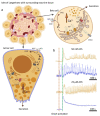Dual Mode of Action of Acetylcholine on Cytosolic Calcium Oscillations in Pancreatic Beta and Acinar Cells In Situ
- PMID: 34201461
- PMCID: PMC8305080
- DOI: 10.3390/cells10071580
Dual Mode of Action of Acetylcholine on Cytosolic Calcium Oscillations in Pancreatic Beta and Acinar Cells In Situ
Abstract
Cholinergic innervation in the pancreas controls both the release of digestive enzymes to support the intestinal digestion and absorption, as well as insulin release to promote nutrient use in the cells of the body. The effects of muscarinic receptor stimulation are described in detail for endocrine beta cells and exocrine acinar cells separately. Here we describe morphological and functional criteria to separate these two cell types in situ in tissue slices and simultaneously measure their response to ACh stimulation on cytosolic Ca2+ oscillations [Ca2+]c in stimulatory glucose conditions. Our results show that both cell types respond to glucose directly in the concentration range compatible with the glucose transporters they express. The physiological ACh concentration increases the frequency of glucose stimulated [Ca2+]c oscillations in both cell types and synchronizes [Ca2+]c oscillations in acinar cells. The supraphysiological ACh concentration further increases the oscillation frequency on the level of individual beta cells, inhibits the synchronization between these cells, and abolishes oscillatory activity in acinar cells. We discuss possible mechanisms leading to the observed phenomena.
Keywords: Ca2+ oscillations; acetylcholine; acinar cell; beta cell; pancreas tissue slices.
Conflict of interest statement
The authors declare no conflict of interest. The funders had no role in the design of the study; in the collection, analyses, or interpretation of data; in the writing of the manuscript, or in the decision to publish the results.
Figures



Similar articles
-
Direct activation of cytosolic Ca2+ signaling and enzyme secretion by cholecystokinin in human pancreatic acinar cells.Gastroenterology. 2008 Aug;135(2):632-41. doi: 10.1053/j.gastro.2008.05.026. Epub 2008 May 7. Gastroenterology. 2008. PMID: 18555802
-
A role for phosphorylation of inositol 1,4,5-trisphosphate receptors in defining calcium signals induced by Peptide agonists in pancreatic acinar cells.J Biol Chem. 2002 Aug 30;277(35):31949-56. doi: 10.1074/jbc.M204318200. Epub 2002 Jun 13. J Biol Chem. 2002. PMID: 12065595
-
Modelling the transition from simple to complex Ca²⁺ oscillations in pancreatic acinar cells.J Biosci. 2014 Jun;39(3):463-84. doi: 10.1007/s12038-014-9430-3. J Biosci. 2014. PMID: 24845510
-
Cannabinoid receptor subtype 2 (CB2R) agonist, GW405833 reduces agonist-induced Ca(2+) oscillations in mouse pancreatic acinar cells.Sci Rep. 2016 Jul 19;6:29757. doi: 10.1038/srep29757. Sci Rep. 2016. PMID: 27432473 Free PMC article.
-
Oscillations of cytosolic calcium in single pancreatic acinar cells stimulated by acetylcholine.FEBS Lett. 1988 Nov 7;239(2):358-62. doi: 10.1016/0014-5793(88)80951-7. FEBS Lett. 1988. PMID: 3141216
Cited by
-
Effects of Different Photoperiods on Growth Performance, Glucose Metabolism, Acetylcholine, and Its Relative Acetylcholine Receptor Modulation in Broiler Chickens.Animals (Basel). 2024 Oct 17;14(20):3003. doi: 10.3390/ani14203003. Animals (Basel). 2024. PMID: 39457933 Free PMC article.
-
Ultrafast multicellular calcium imaging of calcium spikes in mouse beta cells in tissue slices.Acta Physiol (Oxf). 2025 Feb;241(2):e14261. doi: 10.1111/apha.14261. Acta Physiol (Oxf). 2025. PMID: 39803792 Free PMC article.
-
Assessing acute pancreatitis: A novel method combining live cell imaging with tissue damage evaluation.Histol Histopathol. 2025 Sep;40(9):1405-1413. doi: 10.14670/HH-18-882. Epub 2025 Feb 4. Histol Histopathol. 2025. PMID: 39936546
-
High-resolution analysis of the cytosolic Ca2+ events in β cell collectives in situ.Am J Physiol Endocrinol Metab. 2023 Jan 1;324(1):E42-E55. doi: 10.1152/ajpendo.00165.2022. Epub 2022 Nov 30. Am J Physiol Endocrinol Metab. 2023. PMID: 36449570 Free PMC article.
-
Bridging the Gap: Pancreas Tissue Slices From Organ and Tissue Donors for the Study of Diabetes Pathogenesis.Diabetes. 2024 Jan 1;73(1):11-22. doi: 10.2337/dbi20-0018. Diabetes. 2024. PMID: 38117999 Free PMC article. Review.
References
Publication types
MeSH terms
Substances
Grants and funding
LinkOut - more resources
Full Text Sources
Miscellaneous

